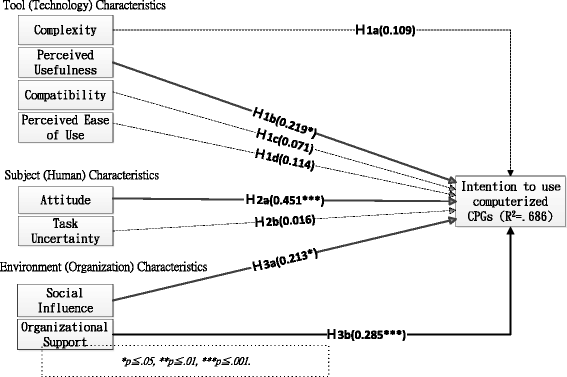Critical factors influencing physicians' intention to use computerized clinical practice guidelines: an integrative model of activity theory and the technology acceptance model
- PMID: 26772169
- PMCID: PMC4715302
- DOI: 10.1186/s12911-016-0241-3
Critical factors influencing physicians' intention to use computerized clinical practice guidelines: an integrative model of activity theory and the technology acceptance model
Abstract
Background: With the widespread use of information communication technologies, computerized clinical practice guidelines are developed and considered as effective decision supporting tools in assisting the processes of clinical activities. However, the development of computerized clinical practice guidelines in Taiwan is still at the early stage and acceptance level among major users (physicians) of computerized clinical practice guidelines is not satisfactory. This study aims to investigate critical factors influencing physicians' intention to computerized clinical practice guideline use through an integrative model of activity theory and the technology acceptance model.
Methods: The survey methodology was employed to collect data from physicians of the investigated hospitals that have implemented computerized clinical practice guidelines. A total of 505 questionnaires were sent out, with 238 completed copies returned, indicating a valid response rate of 47.1 %. The collected data was then analyzed by structural equation modeling technique.
Results: The results showed that attitudes toward using computerized clinical practice guidelines (γ = 0.451, p < 0.001), organizational support (γ = 0.285, p < 0.001), perceived usefulness of computerized clinical practice guidelines (γ = 0.219, p < 0.05), and social influence (γ = 0.213, p < 0.05) were critical factors influencing physicians' intention to use computerized clinical practice guidelines, and these factors can explain 68.6 % of the variance in intention to use computerized clinical practice guidelines.
Conclusions: This study confirmed that some subject (human) factors, environment (organization) factors, tool (technology) factors mentioned in the activity theory should be carefully considered when introducing computerized clinical practice guidelines. Managers should pay much attention on those identified factors and provide adequate resources and incentives to help the promotion and use of computerized clinical practice guidelines. Through the appropriate use of computerized clinical practice guidelines, the clinical benefits, particularly in improving quality of care and facilitating the clinical processes, will be realized.
Figures
Similar articles
-
An investigation on physicians' acceptance of hospital information systems: a case study.Int J Med Inform. 2012 Dec;81(12):810-20. doi: 10.1016/j.ijmedinf.2012.05.003. Epub 2012 May 29. Int J Med Inform. 2012. PMID: 22652011
-
Predictive factors of telemedicine service acceptance and behavioral intention of physicians.Int J Med Inform. 2014 Aug;83(8):559-71. doi: 10.1016/j.ijmedinf.2014.05.005. Epub 2014 Jun 2. Int J Med Inform. 2014. PMID: 24961820
-
Development of a tripolar model of technology acceptance: Hospital-based physicians' perspective on EHR.Int J Med Inform. 2017 Jun;102:50-61. doi: 10.1016/j.ijmedinf.2017.02.013. Epub 2017 Mar 2. Int J Med Inform. 2017. PMID: 28495348
-
The inhibiting effects of resistance to change of disability determination system: a status quo bias perspective.BMC Med Inform Decis Mak. 2020 Apr 29;20(1):82. doi: 10.1186/s12911-020-1090-7. BMC Med Inform Decis Mak. 2020. PMID: 32349754 Free PMC article. Review.
-
Referring physicians' intention to use hospital report cards for hospital referral purposes in the presence or absence of patient-reported outcomes: a randomized trial.Eur J Health Econ. 2024 Mar;25(2):293-305. doi: 10.1007/s10198-023-01587-6. Epub 2023 Apr 13. Eur J Health Econ. 2024. PMID: 37052802 Free PMC article. Review.
Cited by
-
The acceptance level of Hospital Information Management System (HIMS) among the nursing officials working in a teaching hospital.J Educ Health Promot. 2021 Dec 31;10:452. doi: 10.4103/jehp.jehp_1410_20. eCollection 2021. J Educ Health Promot. 2021. PMID: 35233399 Free PMC article.
-
A Systematic Review of the Technology Acceptance Model in Health Informatics.Appl Clin Inform. 2018 Jul;9(3):604-634. doi: 10.1055/s-0038-1668091. Epub 2018 Aug 15. Appl Clin Inform. 2018. PMID: 30112741 Free PMC article.
-
Reducing Pediatric ED Length of Stay by Reducing Diagnostic Testing: A Discrete Event Simulation Model.Pediatr Qual Saf. 2021 Mar 10;6(2):e396. doi: 10.1097/pq9.0000000000000396. eCollection 2021 Mar-Apr. Pediatr Qual Saf. 2021. PMID: 33718751 Free PMC article.
-
Users' Perspectives on a Picture Archiving and Communication System (PACS): An In-Depth Study in a Teaching Hospital in Kuwait.JMIR Med Inform. 2016 Jun 15;4(2):e21. doi: 10.2196/medinform.5703. JMIR Med Inform. 2016. PMID: 27307046 Free PMC article.
-
Exploring the perspectives of primary care providers on use of the electronic Patient Reported Outcomes tool to support goal-oriented care: a qualitative study.BMC Med Inform Decis Mak. 2021 Dec 29;21(1):366. doi: 10.1186/s12911-021-01734-0. BMC Med Inform Decis Mak. 2021. PMID: 34965860 Free PMC article.
References
Publication types
MeSH terms
LinkOut - more resources
Full Text Sources
Other Literature Sources


